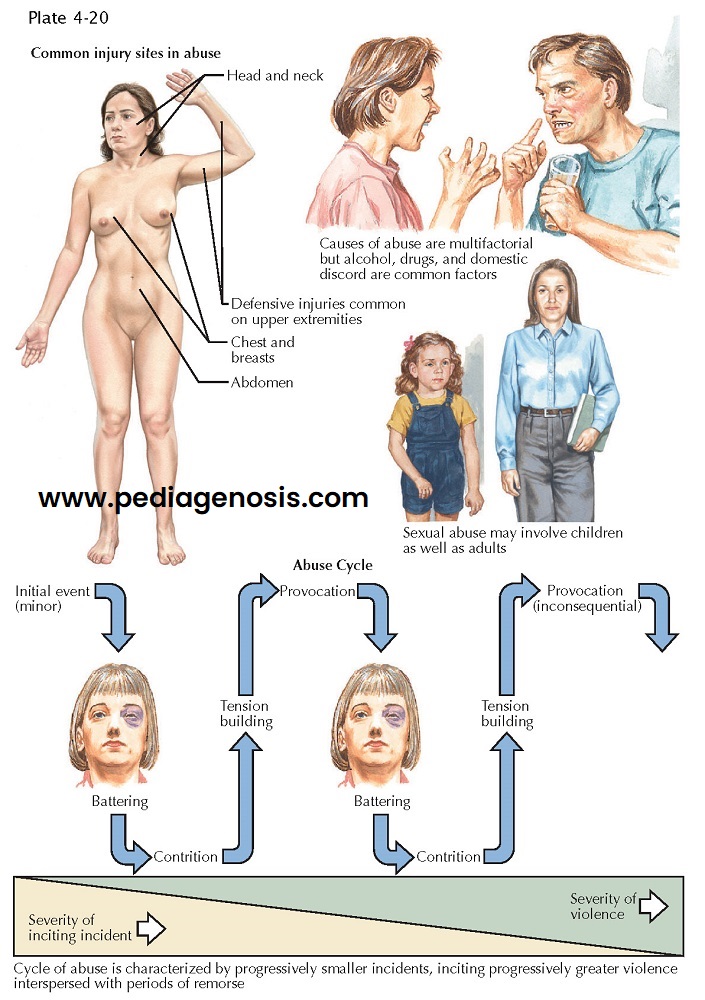Intimate
Partner Abuse
Intimate partner abuse refers to physical, sexual or psychologic
maltreatment by a current or prior partner or spouse. It can take place in the context
of heterosexual or same-sex couples and can consist of a single incident or
recurrent, severe violence lasting many years.
There are four major categories of intimate partner abuse: (1) physical abuse, whereby physical force is used to kill, disable, injure, or otherwise hurt a partner; (2) sexual abuse, which involves coercing a partner to engage in a sex act without consent; 3) threats of violence, in which verbal statements, gestures, or weapons convey a desire to kill, disable, injure, or otherwise hurt a partner; and 4) psychologic or emotional abuse, including insults, controlling behavior, deliberate damage to self-esteem, stalking, and preventing a partner from accessing family, friends, information, money, or other resources.
In the United States,
there are 4.8 million physical assaults and rapes of women and 2.9 million
physical assaults of men annually due to intimate partner abuse. In 2007, there
were 2,340 deaths in the United States due to intimate partner violence, of
which 70% were women and 30% were men.
Clinical
Presentation and Diagnosis. Risk factors for intimate partner abuse include poor self-esteem,
poverty, substance use disorders, minimal social supports, belief in strict
gender roles, social isolation, past experience of physical or psychologic
abuse, borderline personality disorder (Plate 4-18), antisocial personality
disorder (Plate 4-19), relationship instability, financial stressors, and
community tolerance of intimate partner violence.
Victims of intimate
partner abuse can present with physical injuries, such as scratches, cuts,
bruises, welts, broken bones, internal bleeding, and head trauma. The
psychologic trauma from intimate partner violence can manifest as depression,
suicidal ideation and attempts, flashbacks, panic attacks, and difficulty
sleeping.
The pneumonic SAFE (Sebastian,
1996) is often used to facilitate the discussion of intimate partner abuse by
asking about (1) Stress and Safety in the relationship, (2) being Afraid of or Abused
by one’s partner, (3) having Friends or Family who can serve as
social supports, and (4) having an Emergency plan if in danger.
Management. Physicians must provide victims of
intimate partner abuse with an environment where they feel safe. A thorough
history and physical examination are required, with detailed documentation in
the medical record of all findings and interventions. Intimate partner abuse
must be acknowledged to the patient, who needs to be told that there is no
excuse for abuse and that he or she is not at fault.
The patient must receive
medical and surgical treatment as needed for sequelae of abuse, as well as
evaluation for signs and symptoms of psychologic trauma. Victims need to be
warned that violence often becomes more severe with time. A risk assessment
should evaluate the safety of victims and their children. Intimate partner
abuse must be reported to legal authorities if appropriate. Physicians need to
formulate a safety plan with the patient and offer referrals for shelter, legal
assistance, and mental health services.
Course. Lenore Walker published a theory in
1979 that describes the cyclic pattern of abusive relationships: (1) the tension-building
phase occurs before an abusive incident and involves mounting tension in
the setting of ineffective communication and passive-aggressive behavior; (2)
the acting-out phase involves violent or otherwise abusive acts; (3) the
reconciliation/ honeymoon
phase, which
consists of statements of apology, displays of affection, or attempts to
overlook the preceding abuse, followed by a “calm phase.”
In addition to an
increased risk of bodily injury and even murder, intimate partner abuse can
negatively impact a victim’s physical health in the form of headaches,
fibromyalgia, irritable bowel syndrome, cardiovascular disorders, gastrointestinal
disorders, gynecologic disorders, neurologic disorders, sexually transmitted
illnesses, and obstetric complications, such as poor neonatal health and
perinatal death. Psychologic sequelae
can include depression, anxiety disorders, eating disorders, substance use
disorders, high-risk sexual behaviors, suicidality, low self-esteem,
dissociative disorders, and posttraumatic stress disorder.
Of note, more than 3 million children in the United States witness intimate partner violence each year. Observing intimate partner abuse in the home can have an adverse effect on the emotional, social, behavioral, and cognitive development of a child, as well as increasing the likelihood that the child will engage in intimate partner abuse later in life.





